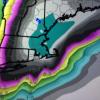-
Posts
90,892 -
Joined
-
Last visited
-
Yep. Not biting unless other guidance latches on…but particularly the euro. GGEM and Ukie can do what they want but if GFS/Euro start agreeing then it’s a legit threat.
-
Yep. esp in March....you get a lot more convection down south this month and things don't always play quite as "smoothly" on guidance as it does in the heart of winter. Still obviously maintaining a lot of skepticism on a big event, but I'm not dismissing it with this much lead time.
-
We got one last year in January I think.
-
Yeah that’s almost a juiced-look version of a Feb 2013 phase job. It’ll be either over DTW or Bermuda by verification time for sure…
-
Don’t think anyone is escaping the torching cutter next week. The slow decline starts for everyone by that point.
-
EPS still has the 3/9 signal. Prob our last chance of anything significant outside of a rogue late season event.
-
Our cold shots this year were extremely mundane. I don’t even think we got below 0 once (I know the radiators near me did). Got close a couple times. One of the cold shots got NNE pretty good with the radiators. But outside of that we just rarely got anything from the “Montreal Express” trajectory that typically defines our deeper cold shots. Everything was from the west or even WSW at times. But that’s the type of pattern that really gets big cold down to the gulf states which is exactly what happened. The only reason the winter felt cold was because it was compared to the last 2 winters and we did not get any true torches after that pre-New Years week. It was a lot of “seasonable cold” that rarely got interrupted and when it did, the mild-ups were quite short and weak.
-
They prob grab a few in each event. I don’t know if they’ll get enough to cover some of the refrozen stuff that will inevitably happen this week…but I’m sure the groomed cruisers will be totally fine.
-
A pasty inch or so wouldnt surprise me in ORH county....even near you. But yeah, best chance is def typical spots near and N of rt 2.
-
I’d never heard of that but that is a sick twist of irony. 86-87 was one of the few good winters in an otherwise crap decade in these parts. Had a decent number of storms near or just inside the BM. Then we went on hiatus for years…’87-88 was actually semi-decent (esp January) but it kind of shit the bed after early February.
-
When looking closer, you can see the winds are stronger down in southern areas. Must just be mixing better overall on top of the usual latitude gradient in temps that is enhancing the difference.
-
Dec ‘92 is the one that really broke the drought. Though it was frustrating along the coast.
-
Technically your jackpot was 3/13/18 but close enough. If we could close the winter with one big dog (doesn’t even have to be HECS-style…just a solid 12”+ type event), it would def take it out of ratter territory considering the other factors (Holiday snow cover, almost continuous stretch of snow cover post-1/11 until later this week)
-
What a torch in SE MA into parts of RI/CT. Wonder if there is a snow cover effect enhancing the gradient. Solid 10F warmer than 20 miles N or NW.
-
Went from 2F too warm for the last 4+ years to 3F+ too cold today.








